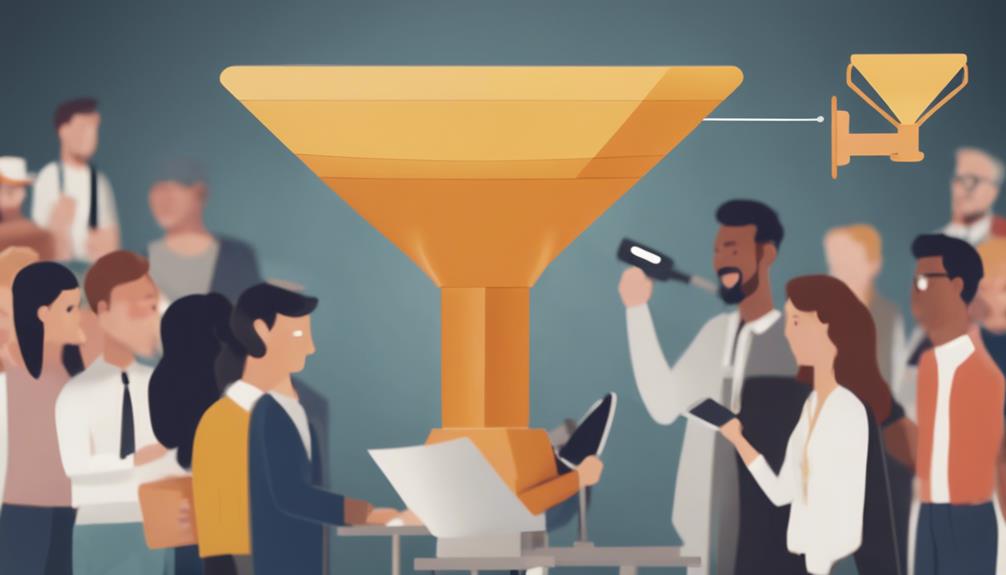Creating Content for Each Stage of Funnel
You're likely no stranger to the concept of a sales funnel, but are you creating content that effectively guides potential customers through each stage? From awareness to post-sale engagement, the type of content you produce plays a pivotal role in nurturing leads and driving conversions. But what exactly does this look like in practice? How do you craft attention-grabbing headlines, educational content, and trust-building case studies that resonate with your target audience? Let's take a closer look at the types of content that work best at each stage of the funnel – and why they're essential to your business's success.
Key Takeaways
- Create attention-grabbing headlines and engaging visuals to make a lasting impression at the awareness stage.
- Develop informative guides, eBooks, and whitepapers to educate and build trust with potential customers at the consideration stage.
- Use case studies, testimonials, and ROI analysis to build credibility and justify investment at the decision-making stage.
- Implement an exhaustive onboarding program and provide exclusive discounts to encourage post-sale engagement and loyalty.
Content for Awareness Stage
When you're creating content for the awareness stage, you'll typically produce pieces that are frequently shared, widely consumed, and designed to grab the attention of potential customers who are just starting to think about solving a problem or meeting a need. Your goal is to make a lasting impression, generate interest, and position your brand as a trusted authority in the industry.
To achieve this, focus on crafting attention-grabbing headlines, creating engaging visuals, and producing informative yet concise content. Leverage social media platforms to amplify your message and reach a wider audience. Utilize platforms like Facebook, Twitter, LinkedIn, and Instagram to share bite-sized, shareable content that resonates with your target audience.
Consider partnering with influencers who've a genuine interest in your brand or niche. Their endorsement can help build credibility and expand your reach. When collaborating with influencers, confirm that their values align with yours and that they've an engaged following that matches your target audience.
Nurturing Leads in Consideration
As potential customers progress from the awareness stage to the consideration stage, they're no longer just browsing for information – they're actively evaluating solutions to their problems, and it's your job to nurture these leads by providing content that addresses their specific pain points and concerns.
To effectively nurture leads at this stage, you need to provide educational content that resonates with them.
Develop informative guides, eBooks, and whitepapers that dive deeper into the solutions you offer.
Your goal is to educate and enlighten potential customers on the benefits and value of your product or service.
For example, if you're a marketing software company, you might create a lead magnet like 'The Ultimate Guide to Inbound Marketing' or 'The Science Behind Lead Generation'.
These types of content assets provide value while positioning your brand as a thought leader in the industry.
By offering relevant and valuable content, you'll build trust and credibility with potential customers, moving them closer to making a purchasing decision.
Effective nurturing at this stage is vital to keeping leads engaged and invested in your brand.
Decision-Making Content Strategies
To seal the deal, you need to create content that speaks directly to the decision-maker's concerns, addressing the final hurdles that stand between them and a purchasing decision. At this stage, your content should be highly targeted and aligned with the decision-maker's needs.
| Content Type | Goals | Tactics |
|---|---|---|
| Case Studies | Build trust and credibility | Highlight success stories, use data and metrics to demonstrate results |
| Testimonials | Address concerns and objections | Use customer quotes and reviews to showcase satisfaction and loyalty |
| ROI Analysis | Justify the investment | Provide a clear breakdown of costs and benefits, use data to demonstrate ROI |
To create effective decision-making content, focus on persuasive storytelling. Use real-life examples and data to demonstrate the value of your product or service. Align your content with the decision-maker's needs and concerns, and use tactics like social proof and ROI analysis to build trust and credibility. By doing so, you'll be able to overcome the final hurdles and seal the deal. Remember, the key is to create content that resonates with your audience and addresses their concerns directly.
Content for Post-Sale Engagement
Now that the deal is sealed, what's the plan for keeping customers engaged and ensuring long-term satisfaction? This is where post-sale engagement content comes in – to nurture the relationship and turn customers into loyal advocates. Your goal is to make them feel valued, supported, and empowered to get the most out of their purchase.
To achieve this, consider creating content that addresses their needs and concerns during this stage.
Customer Onboarding: Develop an exhaustive onboarding program that includes tutorials, webinars, and FAQs to help customers get started with your product or service.
Referral Incentives: Implement a referral program that rewards customers for inviting friends and family to try your product or service.
Exclusive Offers: Provide exclusive discounts, promotions, or early access to new features to make customers feel special and valued.
User-Generated Content: Encourage customers to share their success stories, testimonials, or user-generated content to build trust and credibility.
Measuring Funnel Content Success
Measuring the success of your funnel content is crucial in determining whether your strategy is driving the desired results, and you'll want to track key metrics that indicate engagement, conversion, and customer satisfaction.
You'll need to define what success looks like for each stage of your funnel and identify the corresponding metrics to measure. For example, at the awareness stage, you might track website traffic, social media engagement, and blog post views. At the consideration stage, you might focus on lead generation, email open rates, and content downloads.
To get a more nuanced view of your funnel's performance, consider using funnel metrics such as conversion rates, drop-off points, and time-to-conversion.
You can also use content scoring to evaluate the effectiveness of individual pieces of content in driving engagement and conversion. By tracking these metrics and adjusting your strategy accordingly, you'll be able to optimize your funnel and improve the overall customer experience.
Frequently Asked Questions
How Often Should I Post Content on Social Media?
You're wondering how often to post on social media? Develop a content calendar that aligns with your social media strategy. Aim for 3-5 posts per week, but prioritize quality over quantity to engage your audience effectively.
Can I Reuse Content Across Different Stages of the Funnel?
You're wondering if you can reuse content across different stages of the funnel. While it's tempting to repurpose content, be cautious of content duplication. Effective content mapping can help you identify opportunities for strategic reuse.
What Is the Ideal Content Length for Each Stage?
When crafting content, you're probably wondering what's the ideal length to grab your audience's attention. Considering content snackability, you'll want to keep it concise, as audience attention span is shorter than ever, averaging just 8 seconds.
How Do I Measure the Success of My Content Team?
You measure the success of your content team by tracking key metrics like engagement rates, lead generation, and conversion rates using content analytics tools, and evaluating team performance through regular reviews and goal assessments.
Can I Use Customer Testimonials at Every Stage?
You're leveraging customer testimonials – great move! Social proof is vital, and testimonials offer credibility. Use them strategically, but don't overdo it. Authenticity is key, so verify they're genuine and specific to resonate with your audience.
Conclusion
You've learned how to create content for each stage of the funnel, from attention-grabbing headlines to onboarding programs.
By tailoring your content to each stage, you'll guide potential customers through their buying journey, build trust, and foster engagement.
Now, it's time to put your strategy into action. Measure your funnel content's success, refine your approach, and watch your business thrive.
A well-optimized funnel is the key to converting leads into loyal customers.







